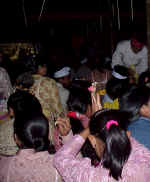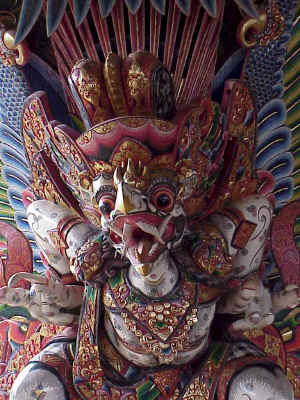Fundamentals of Hinduism in Bali
The Tattwa has five principal beliefs (Panca Crada):
Brahman – The belief in the existence of one almighty God
Atman – The belief in the soul and the spirit
Samsara – The belief in reincarnation
Karma Phala – Belief in the law of reciprocal actions (one gets back, eventually, what one gives out)
Moksha – The belief in the possibility of unity with the divine (Moksa).
The Susila (etiquette) places emphasis on three major rules for behavior (Tri Kaya Parisudha)
Rule Number 1- To think good thoughts
Rule Number 2 - To talk good and honestly
Rule Number 3 - To do good deeds
As well there is an important code of Hindu Dharma called Tat Twam Asi – “You are as I am” and I as you, in other words, “to feel the feeling of one’s fellow beings”. This teaches to treat others as you would treat yourself
Upacara (ritual) is divided into five areas of holy sacrifice (Panca Yadnya):
Dewa Yadnya – holy rituals for the gods
Pitra Yadnya – holy rituals for the higher spirits, and “rites of death.
Rsi Yadnya – holy rituals for the holy Hindu prophets (resis).
Manusa Yadnya – rituals for and on behalf of humans (from the baby in womb until marriage and death)
Bhuta Yadnya – sacrifices for neutralizing the negative influences from the natural and supernatural worlds.
Hinduism is a monotheistic religion with one god, in Bali called “Ida Sang Hyang Widhi”, “Sang Hyang Tunggal”, of “Sang Hyang Cintya”; Hinduism is often misunderstood as being a faith with many gods and goddesses (Dewas and Bhataris). These other gods are merely realizations or manifestations of the holy rays from the one God. The word Dewa (Deva) comes from the Sanskrit word Dev, meaning ray.
Bhatara comes from the word Bhatr, meaning protector. The Dewas, or holy manifestation of God which appear most often in Balinese religion are called the Tri Murti or the holy trinity.
In Bali the Pedanda, (high priest), selected from the Brahmana castel, officiates at large ceremonies. The Pemangku, or village temple priest, looks after the temple and leads the holy rituals included in the Panca yadnya.
The holy books of the Hindu religion are the Vedas (hundreds of books make up the Vedas), which originated in ancient India. Two of books, which reached Bali, are the Catur and the Veda Catur, which are still used by the priests in carrying out religious duties.
In Bali religion is taught in many forms the most popular if these are the Purana, or morality plays, and the Ramayana and the Mahabrata. The many theatre forms – the wayang shadow puppet plays, the masked drama, the opera and ballets are also vehicles of religious teaching.
The island of Bali is full of spirituality and love, the love that spends an hour making an offering of woven palm leaves and flowers, the love that finds the time everyday to think of their spirituality, and the whispering of a mantra with sacred movements.
On this island there is a link to enlightenment, The Balinese feel themselves to be a blessed people, a feeling continually reinforced by the wealth of their everyday life, and strengthened by the splendor of their religion. It is almost as if the Balinese people are living the art of continually worshiping. To the Balinese, Bali is the only “real” world and the sacred mountain Gunug Agung is the “navel of the world”.
Note
The Hindu faith in Bali is very different from that practiced in India.
The differences are very difficult to explain an almost impossible to understand
without full knowledge of two books Srimad Bhagatam and Bhagawad Gita.
These books are over 5000 years old and where written by Rsi Vyasa Deva the
disciple of Narada Muni. Narada Muni is the disciple of Brahma and Brahma
the direct disciple of Krishna also known as Rama. If you would like
to learn more it is possible to buy Srimad Bhagatam and Bhagawad Gita in bookstores
throughout the world in many different languages.

